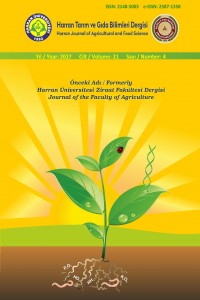Abstract
Nitrogen fertilization is a costly and difficult issue in wheat production. While optimizing nitrogen management increases yield and quality, ıt reduces the negative effect of excess nitrogen on the environment. The application of nitrogen fertilizers in three periods, with sowing, in tillering and possibly in flowering, increases the nitrogen uptake efficiency. The nitrogen fertilizer in development period increases the grain yield, while fertilizer in last period increases the protein ratio. When determining the amount of nitrogen to be applied, it is essential to know the amount of nitrogen in the soil, the yield, the expected yield. Expected yield; it is accepted as 5% more than the average value obtained by subtracting the lowest and highest yields in the last few years. If the yield and protein ratio determine in the harvesting period, the results will provide insight into the correctness of the fertilization and will refer to next years. If the protein is high, it is mean that over fertilized, while if it is low, it is mean that insufficient fertilized.
References
- Alley M.M., Scharf P., Brann D.E., Baethgen W.E. and Hammons J.L., 2009. Nitrogen Management for Winter Wheat: Principles and Recommendations. Virginia Cooperative Extension, Publication 424-026
- Anderson N., Hart J., Christensen N., Mellbye M. and Flowers M., 2010. Using the Nitrogen Mineralization Soil Test to Predict Spring Fertilizer N Rate for Soft White Winter Wheat Grown in Western Oregon. Oregon State University Extension Service, EM 9020
- Anderson W.K. and Impiglia A,. 2002. Management of dryland wheat. Edited by Curtis BC, Rajaram S. Macpherson HG. Bread Wheat: Improvement and Production. FAO Plant Production and Protection Series, No:30
Abstract
Buğday üretiminde azot gübrelemesi maliyetli ve zor bir konudur. Uygun azot yönetimi verimi ve kaliteyi arttırırken, fazla azotun çevre üzerinde olumsuz etkisini azaltır. Azotlu gübrelerin ekimle birlikte, kardeşlenme ve mümkünse çiçeklenme döneminde olmak üzere 3’e bölünerek uygulanması azot alım etkinliğini arttırmaktadır. Gelişme döneminde verilen azot tane verimi, son dönemde verilen ise protein oranı üzerinde etkili olmaktadır. Uygulanacak azot miktarını belirlerken esas olarak topraktaki mevcut azot miktarı ile o tarladan elde edilen ve beklenen tane veriminin bilinmesi gerekir. Beklenen verim; son birkaç yıldaki en düşük ve en yüksek verimler çıkarılarak bulunan ortalama değerin %5 fazlası olarak kabul edilmektedir. Hasat döneminde verimin ve protein oranının tespit edilerek kaydedilmesi yapılan gübrelemenin doğruluğunu hakkında fikir verecek ve gelecek yıllara referans olacaktır. Protein oranının istenenden yüksek olması fazla gübreleme, düşük olması ise eksik gübreleme yapıldığı anlamına gelecektir.
References
- Alley M.M., Scharf P., Brann D.E., Baethgen W.E. and Hammons J.L., 2009. Nitrogen Management for Winter Wheat: Principles and Recommendations. Virginia Cooperative Extension, Publication 424-026
- Anderson N., Hart J., Christensen N., Mellbye M. and Flowers M., 2010. Using the Nitrogen Mineralization Soil Test to Predict Spring Fertilizer N Rate for Soft White Winter Wheat Grown in Western Oregon. Oregon State University Extension Service, EM 9020
- Anderson W.K. and Impiglia A,. 2002. Management of dryland wheat. Edited by Curtis BC, Rajaram S. Macpherson HG. Bread Wheat: Improvement and Production. FAO Plant Production and Protection Series, No:30
Details
| Subjects | Agricultural Engineering |
|---|---|
| Journal Section | Derleme Makaleleri |
| Authors | |
| Publication Date | December 20, 2017 |
| Submission Date | January 23, 2017 |
| Published in Issue | Year 2017 Volume: 21 Issue: 4 |
Cited By
Farklı Gübre Kaynaklarının ve Dozlarının Makarnalık Buğdayın (Triticum durum L.) Verimine Etkisi
Uluslararası Tarım ve Yaban Hayatı Bilimleri Dergisi
https://doi.org/10.24180/ijaws.1479777
Indexing and Abstracting


